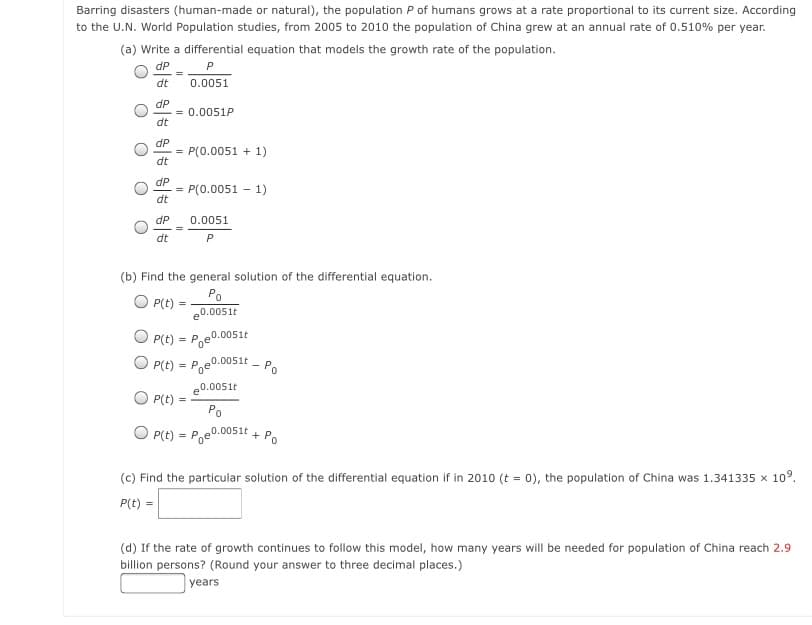Barring disasters (human-made or natural), the population P of humans grows at a rate proportional to its current size. According to the U.N. World Population studies, from 2005 to 2010 the population of China grew at an annual rate of 0.510% per year. (a) Write a differential equation that models the growth rate of the population. dP P 0.0051 dt dP 0.0051P dt dP = P(0.0051 + 1) dt dP = P(0.0051 - 1) dt dP 0.0051 dt (b) Find the general solution of the differential equation. O P(t) Po e0.0051t P(t) = Poe0.0051t P(t) = Poe0.0051t – pPo %3D e0.0051t P(t) = Po O P(t) = Poe0.0051t + Po (c) Find the particular solution of the differential equation if in 2010 (t = 0), the population of China was 1.341335 x 10°. P(t) = (d) If the rate of growth continues to follow this model, how many years will be needed for population of China reach 2.9 billion persons? (Round your answer to three decimal places.) years
Barring disasters (human-made or natural), the population P of humans grows at a rate proportional to its current size. According to the U.N. World Population studies, from 2005 to 2010 the population of China grew at an annual rate of 0.510% per year. (a) Write a differential equation that models the growth rate of the population. dP P 0.0051 dt dP 0.0051P dt dP = P(0.0051 + 1) dt dP = P(0.0051 - 1) dt dP 0.0051 dt (b) Find the general solution of the differential equation. O P(t) Po e0.0051t P(t) = Poe0.0051t P(t) = Poe0.0051t – pPo %3D e0.0051t P(t) = Po O P(t) = Poe0.0051t + Po (c) Find the particular solution of the differential equation if in 2010 (t = 0), the population of China was 1.341335 x 10°. P(t) = (d) If the rate of growth continues to follow this model, how many years will be needed for population of China reach 2.9 billion persons? (Round your answer to three decimal places.) years
Linear Algebra: A Modern Introduction
4th Edition
ISBN:9781285463247
Author:David Poole
Publisher:David Poole
Chapter6: Vector Spaces
Section6.7: Applications
Problem 16EQ
Related questions
Question

Transcribed Image Text:Barring disasters (human-made or natural), the population P of humans grows at a rate proportional to its current size. According
to the U.N. World Population studies, from 2005 to 2010 the population of China grew at an annual rate of 0.510% per year.
(a) Write a differential equation that models the growth rate of the population.
dP
dt
0.0051
dP
= 0.0051P
dt
dP
= P(0.0051 + 1)
dt
dP
= P(0.0051 - 1)
dt
dP
0.0051
dt
(b) Find the general solution of the differential equation.
Po
P(t)
e0.0051t
P(t) = Poe0.0051t
P(t) = Pe0.0051t - P.
e0.0051t
P(t)
Po
O P(t) = Poe0.005it +
Po
(c) Find the particular solution of the differential equation if in 2010 (t = 0), the population of China was 1.341335 x 10°.
%3D
P(t) =
(d) If the rate of growth continues to follow this model, how many years will be needed for population of China reach 2.9
billion persons? (Round your answer to three decimal places.)
years
Expert Solution
This question has been solved!
Explore an expertly crafted, step-by-step solution for a thorough understanding of key concepts.
This is a popular solution!
Trending now
This is a popular solution!
Step by step
Solved in 2 steps

Knowledge Booster
Learn more about
Need a deep-dive on the concept behind this application? Look no further. Learn more about this topic, advanced-math and related others by exploring similar questions and additional content below.Recommended textbooks for you

Linear Algebra: A Modern Introduction
Algebra
ISBN:
9781285463247
Author:
David Poole
Publisher:
Cengage Learning

Algebra & Trigonometry with Analytic Geometry
Algebra
ISBN:
9781133382119
Author:
Swokowski
Publisher:
Cengage

Linear Algebra: A Modern Introduction
Algebra
ISBN:
9781285463247
Author:
David Poole
Publisher:
Cengage Learning

Algebra & Trigonometry with Analytic Geometry
Algebra
ISBN:
9781133382119
Author:
Swokowski
Publisher:
Cengage